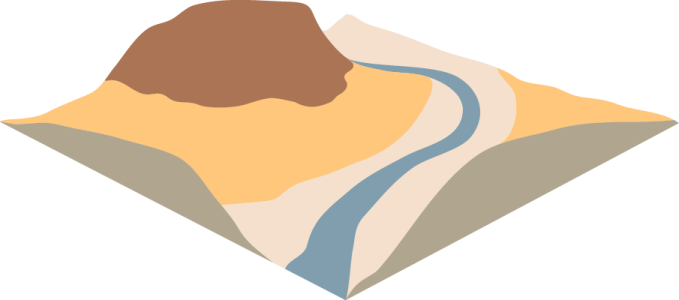Geographical Information Systems Day 2016 was celebrated this past Wednesday – hurrah! As a day dedicated to raising the profile of GIS applications, it provides the perfect opportunity for me to write an update on the progress of my own GIS work, which recently has been focussed on understanding the landscape through satellite imagery.
My last post was about watching the geomorphological world go by from a plane window, and to be honest from there it’s only a short jump to satellite imagery analysis. Add in a good few thousand more metres of altitude and a range of hi-tech instruments that can see what our eyes can and more, before recording it all for us to analyse from the comfort of our desks, and you’re there!
My recent work has been focussed on understanding the different parts of the landscape around a site in Saudi Arabia where, in 2015, we found more than 900 Early and Middle Stone Age lithic artefacts. These artefacts were lying on the surface of a large area of tufa (deposited by past water flow), in a landscape dominated by basalt lava flows from a number of nearby volcanoes.
In order to begin to understand the stone tools we find in the landscape, we need to understand the geomorphological processes that could be moving, hiding or exposing artefacts, as well as the way this landscape has changed over time. Whilst a lot of questions can only be answered by examining the landscape in the field, satellite imagery and other remote sensing imagery give us a broad scale view of the landscape, and the processes that form, and are forming it, and affect the archaeological record it contains.
For this work I’m using satellite imagery from the Pléiades satellites, which produce high resolution images in visible and infra-red light. The ability to change between these bands allows researchers to highlight different properties of the land surface or vegetation. In addition to the different bands (red, green, blue light and near infra-red) a ‘panchromatic’ image combines readings across these bands, resulting in an even higher resolution, but grey-scale, image.

So what to do with this kind of imagery? Well, the opportunities are massive , but to start with, we need to have a good look at the images to identify the different types of landscape that are present in the study area – e.g. basalt lava flows, tufa deposits, alluvium that has been deposited by wadi action etc. Then it’s a case of tracing each of these areas to create polygons within a new shapefile in the GIS package – this can take a looong while, but digitising the data means you can easily display it in different ways, as well as using it to carry out spatial analyses, e.g. testing which landforms have the most artefacts visible on their surfaces and whether or not this is linked to geomorphological processes or patterns of landscape use by past populations.




So what do you do with a classified landscape? At least two things that are important to my work in Saudi Arabia. Firstly, the different areas have different potential for preservation, exposure and visibility of the archaeological record, so can be used to guide archaeological survey, as well as explaining the distributions or concentrations of artefacts that are observed. The flattish basalt lava flows contain raw material for stone tool manufacture, and have relatively little sedimentation on them, so would be areas where you’d expect to find large numbers of artefacts, close to where they were deposited by hominins. Artefacts found in alluvium or channel beds, however, may be buried as well as transported from where they were originally deposited, so hold little potential for finding archaeology, or for understanding the behaviours which lead to their deposition.
The classification also allows us to start to build an understanding of how the landscape has changed over time. This is particularly easy in a setting such as the basalt fields, as each eruption deposits a distinct set of lava flows, which overly older flows. For example, on the right hand side of the map above, there is a prominent basalt flow that is probably the youngest basalt flow in the landscape – indeed, it may post date the tufa, which itself overlies other basalt flows. This has important implications for dating when water was flowing in large quantities and depositing tufa, and reconstructing the landscape at the time of hominin activity at the site. Yet these observations, and a long list of questions from other parts of the study area, can only be confirmed and resolved with a future field.
So that’s a brief introduction to one way of using satellite imagery to learn more about the landscape. Over the next few months I’ll be trying out some automated classification methods to let the computers classify the landforms, but in the meantime, happy belated GIS day!

[…] there’s only so much you can do from looking at an area through Google Earth (despite what I said last month – though it is obviously very useful!), so we set out in 40°C+ heat to take a look around […]
LikeLike
[…] does the distribution of artefacts vary with surface cover, and potentially behavioural factors? Remote-sensing work has given us a good idea of strategy across the wider landscape in terms of which units to date, […]
LikeLike
[…] of the observations made through remote sensing to refine this mapping and expand our ability to plan for next […]
LikeLike